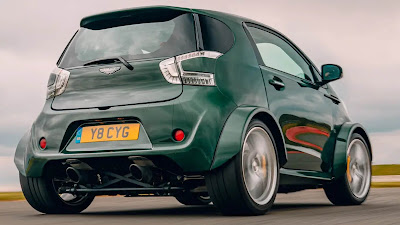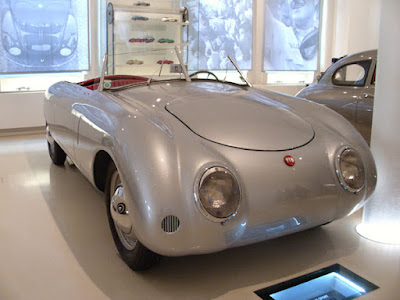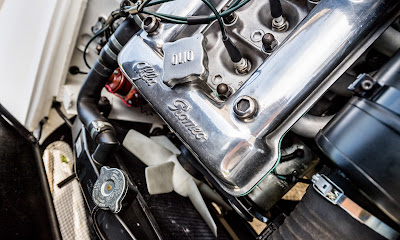Innocent Little DEMON - Aston Martin, a name synonymous with luxury and sophistication, has long been associated with the iconic James Bond franchise. From sleek, powerful sports cars to elegant grand tourers, the brand has cultivated an image of exclusivity and performance. Yet, within this prestigious lineup lies an outlier—a small, 4-cylinder car that might seem out of place among its more illustrious siblings.
 |
| The Aston Martin Cygnet, though proudly wearing the Aston Martin badge, began its life as a modest Toyota iQ. (Picture from: TopGear) |
This car is the Aston Martin Cygnet, a vehicle that, despite bearing the Aston Martin badge, was originally a humble Toyota iQ. While it may be the most affordable Aston Martin ever produced, the Cygnet has often been viewed as a blemish on the brand's otherwise flawless reputation. Even the allure of James Bond couldn’t save this car from the criticism it faced. But why did Aston Martin, known for its grand machines, create something so different?
 |
| The Aston Martin Cygnet, crafted from the humble Toyota iQ in 2011, was designed to avoid hefty emissions penalties imposed by local governments. (Picture from: CNET) |
The answer lies in necessity rather than desire. Aston Martin was compelled to produce the Cygnet back in 2011 as a means to avoid hefty emissions penalties imposed by local governments. The introduction of the Cygnet was not a passionate project driven by the brand’s ethos but rather a strategic move to comply with regulatory requirements.
 |
| The Aston Martin Cygnet, a city car turned high-performance machine, was reimagined by the engineers at Q by Aston Martin. (Picture from: CarPorn) |
However, despite the original Cygnet's cessation of production, Aston Martin decided to revisit the concept with a radical twist. Enter the Aston Martin Cygnet V8, a city car transformed into a high-performance machine, thanks to the engineers at Q by Aston Martin.
 |
| The Cygnet V8's cabin underwent a complete overhaul, featuring a roll cage for safety, Recaro bucket seats for support, and a carbon fiber dashboard for a more aggressive look. (Picture from: AutoNetMagz) |
This revamped version of the Cygnet is nothing like its predecessor. Beneath its compact exterior lies a heart that once powered the Aston Martin Vantage S—a naturally aspirated 4.7-liter V8 engine delivering a staggering 430 horsepower. The combination of this powerful engine and the Cygnet’s lightweight structure results in a car that is significantly more potent than the Vantage S itself. Aston Martin claims that this little dynamo can accelerate from 0 to 100 km/h in just 4.2 seconds, with a top speed of 272 km/h. For a car originally designed for city commuting, these numbers are astonishing.
 |
| Beneath its compact exterior lies a heart that once powered the Aston Martin Vantage S—a naturally aspirated 4.7-liter V8 engine delivering a staggering 430 horsepower. (Picture from: AutoNetMagz) |
However, the transformation from a modest city car to a roaring beast was no easy task. The V8 engine from the Vantage S is traditionally mounted longitudinally, while the original Cygnet, with its 1.3-liter engine, had a transverse layout. This fundamental difference required extensive modifications. Aston Martin’s technicians had to design a new bulkhead and reposition the transmission to accommodate the larger engine. The seven-speed automatic gearbox from the Vantage was retained, but the driveshaft had to be shortened to fit within the Cygnet’s compact frame.
 |
| This extensive reworking transformed the Cygnet from a city car into a true, though highly unconventional, performance machine. (Picture from: TopGear) |
Beyond the engine and transmission, the Cygnet V8 underwent a comprehensive overhaul. A roll cage was installed to enhance safety, Recaro bucket seats were added for improved support, and the dashboard was reconstructed with carbon fiber for a more aggressive look. The suspension was redesigned to handle the increased power, and larger brakes were fitted to ensure the car could stop as effectively as it could accelerate. The front discs measure 380mm and are paired with six-piston calipers, while the rear features 330mm discs with four-piston calipers. This extensive reworking transformed the Cygnet from a city car into a true performance machine, albeit a highly unconventional one.
 |
| The Aston Martin Cygnet V8 made its debut at the Goodwood Festival of Speed, an event that showcases the best in automotive engineering and design. (Picture from: AutoNetMagz) |
The Aston Martin Cygnet V8 made its debut at the Goodwood Festival of Speed, an event that showcases the best in automotive engineering and design. While the car was initially built for this event, it has undoubtedly captured the attention of enthusiasts and critics alike. Its blend of quirky charm and raw power makes it a unique addition to Aston Martin’s storied lineup. The Cygnet V8 stands as a testament to the brand’s ability to innovate and surprise, even when working with the most unlikely of canvases. | T1DGsGqqBh0 |
 In the end, the Aston Martin Cygnet V8 is a fascinating blend of practicality and performance, a car that defies expectations and challenges perceptions. It may have started as a necessity, but it has evolved into something much more—a symbol of Aston Martin’s commitment to pushing boundaries and exploring new possibilities. Whether it’s a car for James Bond or not, the Cygnet V8 has certainly earned its place in the annals of automotive history. ✨Happy Holiday...⛄ *** [EKA | FROM VARIOUS SOURCES | ASTON MARTIN | CNET | TOPGEAR | CARPORN ]
In the end, the Aston Martin Cygnet V8 is a fascinating blend of practicality and performance, a car that defies expectations and challenges perceptions. It may have started as a necessity, but it has evolved into something much more—a symbol of Aston Martin’s commitment to pushing boundaries and exploring new possibilities. Whether it’s a car for James Bond or not, the Cygnet V8 has certainly earned its place in the annals of automotive history. ✨Happy Holiday...⛄ *** [EKA | FROM VARIOUS SOURCES | ASTON MARTIN | CNET | TOPGEAR | CARPORN ]Note: This blog can be accessed via your smart phone





































